The hardiest of the hardiest, and the most widely distributed of the Opuntias. Found growing in portions of 22 States, and 5 Canadian Provinces. This small mounding Opuntia is the most cold tolerant cactus in North America. It can be found growing almost to the Arctic Circle in Alberta and British Columbia.
As the scientific (Opuntia fragilis) and common names (brittle prickly pear) imply, the pads detach easily at the slightest touch. This allows it to vegetatively propagate itself.
There are several isolated populations in the upper mid western states (IA, IL, MN, WI, MI,) that rarely flower. It is believed that these populations use this vegetative method almost exclusively to perpetuate themselves. It has been speculated that Native American traders, or animals may have inadvertently spread it's range eastward, by pads attached to their trappings, furs or hides. There are on going studies of these populations. Here are links to some of the on going studies by Dr. Eric Ribbens concerning these eastern populations.
http://www.wiu.edu/users/mfer1/research/opuntia.htm
http://www.wiu.edu/users/mfer1/research/Opuntia_fragilis/index.htm
http://opuntiads.com/zpdf/opuntia-fragilis-iowa.pdf
http://opuntiads.com/zpdf/opuntia-fragilis-michigan.pdf
http://opuntiads.com/zpdf/opuntia-fragilis-illinois.pdf
The populations found further west tend to flower more, utilizing both floral and vegetative strategies to colonise and reproduce. O. fragilis is known to hybridize with other Opuntias frequently, especially O. Polyacantha. Many natural hybrids are found where it's habitat overlaps with other Opuntias.
There is a fair amount of diversity through out it's natural range. Most noticeable in the shape of the pads and length of the spines. The pads may be oval and plump (egg shaped)or flat, oval shaped pads. The spines can be non nonexistent to twice the length of the pads, coloration ranges from white through red/brown, The flower coloration is always yellow and may sport red filaments. I have heard and seen what are reputed to be pink flowered forms but, I have to agree with the prevailing opinion that, they are of hybrid origin.
There are some who say O. fragilis dose not bloom well for them. I find that the western forms if allowed to chain the pads, two to three long, will set flowers consistently. You want to give it enough moisture to fill out the pads, and plenty of full sun. I recommend a well drained planting medium. It however is known to grow along the British Colombian coast and in wetter micro climates of the Midwestern states, rooted into moss covered, rock crevices and depressions.
Here is an extensive monograph about Opuntia fragilis authored by Dr. Eric Gibbens and published in the Haseltonia 14: 94–110. 2007.
http://opuntiads.com/zpdf/opuntia-fragilis-haseltonia.pdf
Since this species stays low and mounds, I use it in my garden extensively, with eight clones spread through out the garden. I place it back out of the way to avoid disturbance from pets or passers by.
Now for a few shots.
Comments
Re: Opuntia fragilis
Please forgive me, but for the sake of the fragile, winter-worn psyches of Canadians who sometimes wonder if it is indeed creeping closer (case in point, the snowfall here 2 weekends ago), I must point out that the Arctic Circle is still another 450 miles north or so of the northern borders of Alberta and British Columbia. Don't want mass suicides breaking out at the news!
No please forgive me. I guess I went for a little too much dramatic effect! ::)
Re: Opuntia fragilis
I've seen Opuntia fragilis in many places throughout Minnesota (not the ones at the Northwest Angle though), and none of them are as garden worth as your clones depicted here. Very nice!
Re: Opuntia fragilis
Lichen has been shown to have some affect on whether some varieties of O. fragilis will flower or not. I have 8 different var. from various collection locales in Utah and some are shy to flower while others grow two sets of pads and flower twice in the summer. The shy flowering ones generally are thought to have a symbiotic relationship with lichen growing on the soil and on surrounding rocks. If some of the plants do not have this they are believed too rarely if ever flower in cultivation. I grow my shy flowering ones close to rocks covered in lichen in hopes that they will be able to develop this relationship but my rocks are from California and the plants Utah so I don’t expect miracles but there is always hope. My favorite one is O. fragilis forma denudate nearly round pads with almost no spines and a purple hue.
Re: Opuntia fragilis
I have not heard of this symbiotic relationship before. Interesting. I just grow mine on DG with plenty of heat, sun and consistant moderate moisture. They seem to appreciate this treatment. All of my clones flower every year.
Re: Opuntia fragilis
I have done a lot of research on this species and I personally think that it needs to be broken up into different species or subspecies rather than just one. There are so many different forms it is like calling every plant that looks similar the same name. I have two different clones that will not bloom but they bloom great in the wild in Utah likewise they will not bloom in cultivation in Utah in their native soil, "so I know its not just me".
The desert crusts have a biodiversity that we have barely even started to look at. It is a nitrogen fixer and does so many other things that are now starting to be addressed. In certain deserts that have lots of introduced grazing farm animals trampling the native crust the areas are turning into sand dunes since the soil is not protected from the extreme weathering. I love how interconnected the world is, "we are but one organism living in perfect harmony".
Re: Opuntia fragilis
I have read about biological soil crusts. They are indeed an integral and major component of the undisturbed desert landscape. I must say that I had never heard of this specific interrelationship until now. I find it very interesting. Thank you for the information.
Here are a few sights and pdfs that give an overview of soil crusts for those with an interest.
http://www.soilcrust.org/crust101.htm
http://www.mineralarts.com/artwork/cryptos.html
http://www.blm.gov/nstc/library/pdf/CrustManual.pdf
http://www.fs.fed.us/rm/pubs/rmrs_p031/rmrs_p031_074_076.pdf
ftp://ftp-fc.sc.egov.usda.gov/GLTI/technical/publications/micro-crusts.pdf
http://conservancy.umn.edu/bitstream/60123/1/7.2.Kettenring.pdf
Re: Opuntia fragilis
I have not heard of this symbiotic relationship before. Interesting. I just grow mine on DG with plenty of heat, sun and consistant moderate moisture. They seem to appreciate this treatment. All of my clones flower every year.
John, what is DG? An acronym for something?
Re: Opuntia fragilis
It's disintegrated granite. Locally common soil deposits made of weathered crumbled granite particles. It can be a mix of varying sized pieces from 1/2 inch and down. I buy 1/8 inch and down as a planting medium. Many of the golden soils seen on western mountain slopes and screes are composed of this matrix. It has excellent sharp drainage properties and just enough fines to stay damp.
Re: Opuntia fragilis
It's disintegrated granite. Locally common soil deposits made of weathered crumbled granite particles. It can be a mix of varying sized pieces from 1/2 inch and down. I buy 1/8 inch and down as a planting medium. Many of the golden soils seen on western mountain slopes and screes are composed of this matrix. It has excellent sharp drainage properties and just enough fines to stay damp.
Thanks John, DG sounds like good stuff. I don't know of any such material available here, but then again, I haven't really looked.
Re: Opuntia fragilis
James
I correspond occasionally with a DR. Eric Ribbons about Opuntia fragilis. He is an Associate Professor of Biology at Western Illinois University.
Dr Ribbons has been doing research and studies on Midwestern populations of O. fragilis many of which are, as you say are "shy to flower".
Dr. Ribbons web sight has some good information about the species.
http://www.wiu.edu/users/mfer1/research/Opuntia/opuntia.htm
He also authored an article about of the species for the Haseltonia publication in 2007
http://opuntiads.com/zpdf/opuntia-fragilis-haseltonia.pdf
You will find this article and several others Authored By Dr. Ribbons at this sight.
http://opuntiads.com/html/opuntia-fragilis.html
http://opuntiads.com/zpdf/opuntia-fragilis-iowa.pdf
http://opuntiads.com/zpdf/opuntia-fragilis-michigan.pdf
http://opuntiads.com/zpdf/opuntia-fragilis-illinois.pdf
Re: Opuntia fragilis
Thank you for the links.
I was only able to read the first one as of yet, however; I do find the information very interesting. I found the part about the Lichen possibly facilitating flowering by cooling the soil interesting. I feel that the added nitrogen being fixed from the Lichen plays an integral part as well and I agree it holds moisture in the soil.
Here is one of my favorite varieties of Opuntia fragilis var. denudata from Utah.
Re: Opuntia fragilis
John, those are excellent links for Opuntiaphiles (Opuntiads.com), what a fantastic reource, must admit to spending lots of time looking around the galleries and reading up on O. fragilis, I had no idea about its surprising northerly range.
James, what a cute rolly-polly thing Opuntia fragilis var. denudata is, I like it!
Re: Opuntia fragilis
James, what a cute rolly-polly thing Opuntia fragilis var. denudata is, I like it!
I was almost surprised, Mark, with your "no thorns" rule...but then I see that this one has no thorns! (and indeed, cute)
There are, apparently, certain O. humifusa that are thornless, or nearly so. I was hoping the Minnesota provenance ones would be such, but not so.
Re: Opuntia fragilis
Even if they have no thorns they do have glochides (I presume)! I dislike glochides more than thorns.
Though I will look for seeds when I get the seed list.
Re: Opuntia fragilis
Opuntia fragilis var. denudata doesn't have the same kind of glochides like many of the Opuntia do. They are more like reduced thorns not hairs (they are much easier to get out and you can see them easily) and it has a lot less of them unlike my other Opuntia that leave glochides in me all the time. I also dislike glochides. I think this year I will only have four seeds if I am lucky, I didn't hand pollinate them to make sure they where pollinated well.
Re: Opuntia fragilis
Glochides are why I don't grow Opuntia spp. I much rather have the big strong thorns that are easily removed from my person.
Now this makes me think... When I was perusing the O. fragilis in western Minnesota, I got some stuck to my boots a few times. I removed them with my fingers, got stuck a few times, but only by the large thorns and never glochides. Is it possible that that these don't have them?
Regarding pollination, I also find that to get a good crop of seed from my Coryphantha vivipara, I must hand pollinate.
Re: Opuntia fragilis
Rick
Don't kid yourself they are present. You were just lucky you didn't get past the big spines. As far as pads sticking to your boots goes, sounds like they were just doing what they were designed to do. ;)
I find that cool spring weather requires me to take on the pollinating duties. During warm spring weather I have plenty of helpers. :D
Re: Opuntia fragilis
(NB. It' s glochid, not glochide, for those who may be wondering...)
Re: Opuntia fragilis
(NB. It' s glochid, not glochide, for those who may be wondering...)
Thanks, Lori, i for one, did wonder.
I was not quite sure. It is glochide in German, French and Spanish. In Norw. it is (almost) not used in singular, only in plural (glokider/glokidene).
When I visited the Galapagos Islands i had more than one close encounter with the unearthly vegetation with glochids.
Today I have even purchased an Opuntia fragilis!
Re: Opuntia fragilis
This is funny, 'cause I wondered too about the spelling, but was too lazy/tired. It was 1:30 am and a particularly long day for me.
And for those souls wondering how best to grab an opuntia pad with your fingers: it is from the bottom. At least it is with O. fragilis. Most places in Minnesota, it is easy to avoid stepping on cactus. They generally don't cohabit with grasses or other plants when the other plants have the upper hand. Usually, I find them growing with no other species at all. Walk where you don't see cactus, and you are pretty safe. However, Blue Devil Valley was an exception.
Re: Opuntia fragilis
Another nice thread--good work, John!
In Alberta, O fragilis may grow exposed, but often grows among grasses, forbs and shrubs, as does its cousin and interbreeder, O polyacantha
here are some pics from 2008 that some of you will have seen in various places before..
https://picasaweb.google.com/cactuscactus/DrumhellerAlbertaJuly20083#
Trond, where in your shady acreage will you find a place for O fragilis? ;D There are some Scandinavian growers with the most extensive collections of fragilis (among many other things) that I know of.. can't remember right now if any of them are in Norway..
I've had plants of both native Opuntias in years past , also not flowering due to inadequate light in my wooded property -though I put them in sunny spots, just not sunny enough!; I'm planning some new cactus plantings and will be looking for some of the sunniest spots..
James, love the little fatty! I do plan to get a few of the different forms of fragilis-different skin colours, spination etc
Re: Opuntia fragilis
Trond, where in your shady acreage will you find a place for O fragilis? ;D There are some Scandinavian growers with the most extensive collections of fragilis (among many other things) that I know of.. can't remember right now if any of them are in Norway..
I've had plants of both native Opuntias in years past , also not flowering due to inadequate light in my wooded property -though I put them in sunny spots, just not sunny enough!; I'm planning some new cactus plantings and will be looking for some of the sunniest spots..
Cohan, you have a point :( However I can try my shed roof ;) I still have some empty spots there! (Picture from last spring, not today :-[ ) . . .
. . . or at my summerhouse ;D The first picture shows my neighbor's boat and dock, you can detect the chimney of my house among the pines.
Viola tricolor and Armeria maritima
Re: Opuntia fragilis
Trond, where in your shady acreage will you find a place for O fragilis? ;D There are some Scandinavian growers with the most extensive collections of fragilis (among many other things) that I know of.. can't remember right now if any of them are in Norway..
I've had plants of both native Opuntias in years past , also not flowering due to inadequate light in my wooded property -though I put them in sunny spots, just not sunny enough!; I'm planning some new cactus plantings and will be looking for some of the sunniest spots..Cohan, you have a point :( However I can try my shed roof ;) I still have some empty spots there! (Picture from last spring, not today :-[ ) . . .
. . . or at my summerhouse ;D The first picture shows my neighbor's boat and dock, you can detect the chimney of my house among the pines.Viola tricolor and Armeria maritima
I'll have to wait for a time my internet connection is behaving better to enlarge those photos :(
the first is a roof? with all that stone?
the location of your cabin looks great! I know I should be thankful for deep reasonably good soil, but I would love to have a property that had lots of exposed rock!
Re: Opuntia fragilis
I'll have to wait for a time my internet connection is behaving better to enlarge those photos :(
the first is a roof? with all that stone?
the location of your cabin looks great! I know I should be thankful for deep reasonably good soil, but I would love to have a property that had lots of exposed rock!
Re: Opuntia fragilis
Trond, your roof garden never ceases to amaze me...it would be a great way to deal with all the rain we get in my part of the world.
BTW, I am trying O. humilis outdoors this year...now under 4 feet of snow. This will be a test for sure. I have humilis and fragilis in my coldframes...humilis has flowered once but fragilis never has.
Re: Opuntia fragilis
Okay, today I was able to enlarge those images--Tond--love the roof garden ;D and the rock plants at the cabin! Is this the property in the mountains, or a different spot? Looks like it might be similar to places where O fragilis grows on rocks on islands off the coast of British Columbia.
I tracked down one of those North Western European growers I had in mind-- this is Martin in Denmark, and he has a lot of experience with many many C+S in (somewhat) cold and wet conditions.. this is his public gallery, and if there is no contact option there, I can give you his email address privately:
http://public.fotki.com/northern-nursery/
Re: Opuntia fragilis
Okay, today I was able to enlarge those images--Tond--love the roof garden ;D and the rock plants at the cabin! Is this the property in the mountains, or a different spot? Looks like it might be similar to places where O fragilis grows on rocks on islands off the coast of British Columbia.
This is not in the mountains! it is one of the sunniest places in Norway at the south east coast where we have a cabin/summerhouse on an island ;)
http://www.google.no/images?q=krager%C3%B8&oe=utf-8&rls=org.mozilla:nb-N...
http://www.google.no/images?um=1&hl=no&client=firefox-a&rls=org.mozilla%...
I tracked down one of those North Western European growers I had in mind-- this is Martin in Denmark, and he has a lot of experience with many many C+S in (somewhat) cold and wet conditions.. this is his public gallery, and if there is no contact option there, I can give you his email address privately:
http://public.fotki.com/northern-nursery/
Yes please!
Re: Opuntia fragilis
That's what I was wondering, Trond, since you have mentioned a mountain cabin, but this seemed more like coast!
Re: Opuntia fragilis
O. fragilis with winter burn.
Re: Opuntia fragilis
WOW what a great mound!! :o
Is this from a locally collected clone?
Re: Opuntia fragilis
I've just seen this very interesting thread. I managed to overwinter a small seed propagated plant of O. fragilis for two winters here at over 64N (min. temperature, without snowcover of about -23C) but it sadly didn't make it through last winter.
In Scandinavia, I've seen good collections of Opuntias in the rock garden at the Gøteborg (Gothenburg) botanics and they also grow several in the Tromsø botanical gardens (69.6N) where I've even seen an unknown species with flower buds.
Re: Opuntia fragilis
WOW what a great mound!! :o
Is this from a locally collected clone?
Thanks!
It came from a local nursery. Last winter was the first winter I ever seen it burn. We had very cold weather very early. >:(
Re: Opuntia fragilis
I've just seen this very interesting thread. I managed to overwinter a small seed propagated plant of O. fragilis for two winters here at over 64N (min. temperature, without snowcover of about -23C) but it sadly didn't make it through last winter.
In Scandinavia, I've seen good collections of Opuntias in the rock garden at the Gøteborg (Gothenburg) botanics and they also grow several in the Tromsø botanical gardens (69.6N) where I've even seen an unknown species with flower buds.
Would love to see some pics. :)
Re: Opuntia fragilis
Of course any plant can be damaged in a given year, even in nature, so you can't say too much from one plant, but, O fragilis does occur in at least z2 areas in nature, so its not cold per se that can cause problems, and it is said to be even quite tolerant of winter wet.. drainage is really crucial of course, for winter (for really wet winters, I think both extra draining soil and a bit of a slope would be best) , but I think damage can occur also when cold temperatures come hard on the heels of warm weather, and plants have not hardened yet.. we've had a couple of falls like this --warm and wet weather followed by cold, and some little bits of Alberta fragilis I have have not been looking great..
Another factor for hardy cacti (less important I think for the northern Opuntias than Echinocereus etc, but still relevant, I suspect) more important for Stephen and I than for DesertZone, is summer heat--the plants need a good warm/hot growing season to really be in shape for winter.. i think a planting built to maximise heat during summer would be helpful (stones that hold heat, going below soil level as well, and some sort of partial wall/raised area around it to hold heat, or pots/plantings in semi-enclosed areas in courtyards, near walls etc)..
Re: Opuntia fragilis
but I think damage can occur also when cold temperatures come hard on the heels of warm weather, and plants have not hardened yet.. we've had a couple of falls like this --warm and wet weather followed by cold,
Bingo...this is what did so much of my plants in last year, not so much the cold winter but the warm and early cold of fall. Half my flowers were in bloom and then two cold snaps near 0F :o
Re: Opuntia fragilis
We had an especially bad bout of that year before last-- extra warm later than usual in late aug and through sept, then in early oct, snow and freezing for a week, down to -20C.. even native trees were thrown for a loop--they had not dropped leaves, and the leaves froze in place, stayed for weeks, all winter on some things... some very hardy perennials were affected, though most things recovered..
Re: Opuntia fragilis
I had flower that stayed all winter becuase of the freeze. :D
Re: Opuntia fragilis
I wonder if we are headed for that sort of a fall/winter again-- after another cold wet day tomorrow (yesterday drizzle all day and a high of 8C), we are forecast a stretch of warm sunny weather (up to mid-20'sC which is just about as warm as it has been all summer)..
Re: Opuntia fragilis
Gosh, I wish I would have seen these in bloom. I have never even seen a O. fragilis with any buds or flowers in Minnesota before. These are near Granite Falls, Minnesota. They're not exactly the easiest to access...
Re: Opuntia fragilis
Rick
I hope a few pads stuck to you pant legs. ;)
Boy those outcroppings are covered in them!!
Re: Opuntia fragilis
Rick
I hope a few pads stuck to you pant legs. ;)
Boy those outcroppings are covered in them!!
Well, my aversion to the cactus with "jumping" ;) glochides may be set aside for this one, at least until I can get it to bloom and evaluate it. It won't be a space hog like the larger opuntias. There was an old piece of rotting wood there and I used it to reach out and touch some of the pads. the barbed thorns did their job, attached themselves to it, and I retrieved a few pads. That leaves two up for grabs...
Re: Opuntia fragilis
Just a little tip.
Be sure and plant it were it doesn't get bumped around. They will only produce flowers after they chain/stack two or three pads high. So getting bumped around really delays the process.
Re: Opuntia fragilis
Had been exciting to be stung by a cactus ;) ...in the wild, I mean. Although roses are beautiful they're not as interesting as cacti though!
Rick, the other plant in your picture - is it a grass?
Re: Opuntia fragilis
Thanks, John.
Rick, the other plant in your picture - is it a grass?
Yes, the grass looking plants are a rhizomatous grass species. Not sure which, though. I would have thought the Plantago patagonica would be the more interesting plant... ;D
Re: Opuntia fragilis
Thanks, John.
Rick, the other plant in your picture - is it a grass?
Yes, the grass looking plants are a rhizomatous grass species. Not sure which, though. I would have thought the Plantago patagonica would be the more interesting plant... ;D
It is! I did believe that the plantago inflorescences belonged to the grass leaves :o
Re: Opuntia fragilis
Great looking Opuntias, Rick! really nice globular pads! Do you think the flowers were pink, or just faded that way? All or nearly all, Canadian Opuntia have yellow flowers (I've heard a couple reports of pinks, but not actually seen evidence) but I know there are more colours in the U.S.
the Plantago is great too, I'm very interested in that genus.. what are the leaves like? Like Trond, I only saw the grass 'leaves'
Re: Opuntia fragilis
Great looking Opuntias, Rick! Do you think the flowers were pink, or just faded that way?
I'm glad I am not the only one who wondered about that, because we have no wild Minnesota opuntias that bloom anything but yellow. I thought maybe I "discovered" something! But no: I found some pics on the web of blooming yellow opuntia flowers with old flowers on the same plant that faded to pink. Those pads in the previous photos are hardly more than an inch long, so a hybrid with a non-native pink blooming polycantha (in the rare case that someone grew one nearby) would be extremely unlikely, I would think.
I am still collating photos of other prairie plants from that same trip to show here. More About the plantago then...
Re: Opuntia fragilis
I suspected that was the case with this flower, I've seen pinkish faded flowers before..
Looking forward to the other plant photos, I have to get over to the travel photos section, I haven't even seen the photos of Lori's spring trip yet- my internet connection has been so poor the last many weeks, but I think it may have got a bit better....
(its taking two or three re-connections to send this message)

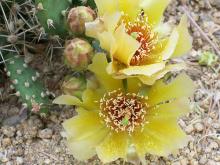
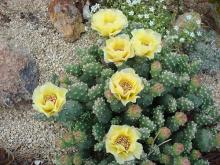
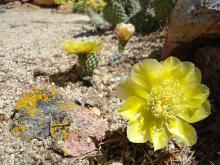
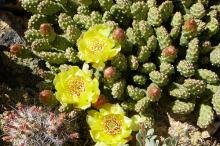
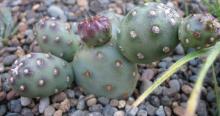
Superb essay, John!
I'm afraid I am one of those for whom it will not bloom... in its current conditions, anyway. I saw a nice specimen on the weekend (on a tour of the fascinating garden of a local botanist) that will soon be covered with blossoms. I'm deeply envious!!
PS. Please forgive me, but for the sake of the fragile, winter-worn psyches of Canadians who sometimes wonder if it is indeed creeping closer (case in point, the snowfall here 2 weekends ago), I must point out that the Arctic Circle is still another 450 miles or so north of the northern borders of Alberta and British Columbia. ;D ;) ;) Don't want mass suicides breaking out at the suggestion that the Arctic Circle has been creeping closer! ;D ;D :D
Terrific photos! I look forward to seeing this species in bloom when we head out to the Red Deer River badlands in summer!
Edit: Here is a range map for O. fragilis (N.B. not a plant of the boreal forest nor of the arctic tundra...):
http://www.efloras.org/object_page.aspx?object_id=13216&flora_id=1